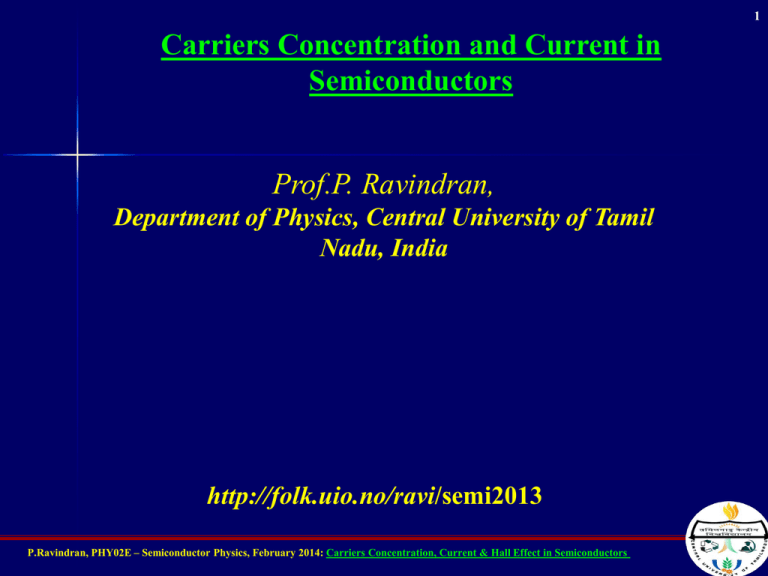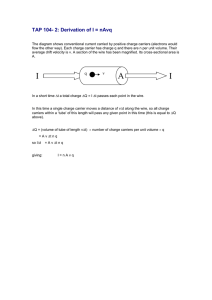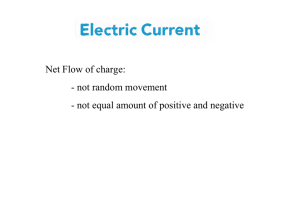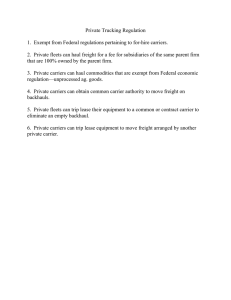Prof.P. Ravindran, Carriers Concentration and Current in
advertisement

1 Carriers Concentration and Current in Semiconductors Prof.P. Ravindran, Department of Physics, Central University of Tamil Nadu, India http://folk.uio.no/ravi/semi2013 P.Ravindran, PHY02E – Semiconductor Physics, February 2014: Carriers Concentration, Current & Hall Effect in Semiconductors Carrier Transport Two driving forces for carrier transport: electric field and spatial variation of the carrier concentration. Both driving forces lead to a directional motion of carriers superimposed on the random thermal motion. To calculate the directional carrier motion and the currents in a semiconductor, classical & nonclassical models can be used. The classical models assume that variation of E-field in time is sufficiently slow so that the transport properties of carriers (mobility or diffusivity) can follow the changes of the field immediately. If carriers are exposed to a fast-varying field, they may not be able to adjust their transport properties instantaneously to variations of the field, and carrier mobility and diffusivity may be different from their steady-state values nonstationary Nonstationary carrier transport can occur in electron devices under both dc and ac bias conditions. P.Ravindran, PHY02E – Semiconductor Physics, February 2014: Carriers Concentration, Current & Hall Effect in Semiconductors 2 Classical Description of Carrier Transport Assume thermal equilibrium for a semiconductor having a spatially homogeneous carrier concentration with no applied E-field. No driving force for directional carrier motion. The carriers not in standstill condition but in continuous motion due to kinetic energy. For electron in the conduction band, E 32 k T m2 v where vth is the thermal velocity, mn* is the conductivity effective electron mass. The average time between two scattering events is the mean free time and the average distance a carrier travels between collisions is the mean free path. Fig. 2.5 (a) Applying V, the E-fields adds a directional component to the random motion of the electron. Fig. 2.5 (b) * n kin B 2 th P.Ravindran, PHY02E – Semiconductor Physics, February 2014: Carriers Concentration, Current & Hall Effect in Semiconductors 3 The mean electron velocity: vn= -μnE The directed unilateral motion of carriers caused by E-field is drift velocity. Similarly, vp = μpE A change in E-field instantaneously results in a change of the drift velocity. P.Ravindran, PHY02E – Semiconductor Physics, February 2014: Carriers Concentration, Current & Hall Effect in Semiconductors 4 Fick’s First Law: relating diffusion current to carrier concentration gradient. dn e De dx e = electron flux, De = diffusion coefficient of electrons, dn/dx = electron concentration gradient Electron Diffusion Current Density dn J D,e ee eDe dx JD, e = electric current density due to electron diffusion, Where: e = electron flux, e = electronic charge, De = diffusion coefficient of electrons, dn/dx = electron concentration gradient P.Ravindran, PHY02E – Semiconductor Physics, February 2014: Carriers Concentration, Current & Hall Effect in Semiconductors Hole Diffusion Current Density dp JD,h eh eDh dx JD, h = electric current density due to hole diffusion, e = electronic charge, h = hole flux, Dh = diffusion coefficient of holes, dp/dx = hole concentration gradient Total Electron Current Due to Drift and Diffusion dn Je en eEx eDe dx Je = electron current due to drift and diffusion, n = electron concentration, e = electron drift mobility, Ex = electric field in the x direction, De = diffusion coefficient of electrons, dn/dx = electron concentration gradient P.Ravindran, PHY02E – Semiconductor Physics, February 2014: Carriers Concentration, Current & Hall Effect in Semiconductors Total Currents Due to Drift and Diffusion dp Jh ephEx eDh dx Jh = hole current due to drift and diffusion, p = hole concentration, h = hole drift mobility, Ex = electric field in the x direction, Dh = diffusion coefficient of holes, dp/dx = hole concentration gradient dn Je en eEx eDe dx Je = electron current due to drift and diffusion, n = electron concentration e = electron drift mobility, Ex = electric field in the x direction, De = diffusion coefficient of electrons, dn/dx = electron concentration gradient Jtotal = Jh+Je P.Ravindran, PHY02E – Semiconductor Physics, February 2014: Carriers Concentration, Current & Hall Effect in Semiconductors Einstein Relation: diffusion coefficient and mobility are related! De kT e e and Dh kT h e De = diffusion coefficient of electrons, e = electron drift mobility, Dh = diffusion coefficient of the holes, h = hole drift mobility P.Ravindran, PHY02E – Semiconductor Physics, February 2014: Carriers Concentration, Current & Hall Effect in Semiconductors Carrier diffusion due to doping level gradient. This is a common device fabrication step. · represents electrons (majority carriers in this case) Exposed As+ Donor n2 Vo Ex n1 Diffusion occurs until an electric field builds up! Note: the As+ are fixed, non-mobile charges! Diffusion Flux Drift Net current = 0 We call this the built-in potential. Fig. 5.32: Non-uniform doping profile results in electron diffusion towards the less concentrated regions. This exposes positively charged donors and sets up a built-in field Ex . In the steady state, the diffusion of electrons towards the right is balanced by their drift towards the left. From Principles of Electronic Materials and Devices, Second Edition, S.O. Kasap (© McGraw-Hill, 2002) http://Materials.Usask.Ca P.Ravindran, PHY02E – Semiconductor Physics, February 2014: Carriers Concentration, Current & Hall Effect in Semiconductors Built-In Potential and Concentration kT n 2 V2 V1 ln e n1 Exposed As+ Donor n2 Vo Ex n1 V2 = potential at point 2, V1 = potential at point 1, n2 = electron concentration at point 2, n1 = electron concentration at point 1 Diffusion Flux Drift Net current = 0 Built-In Field in Nonuniform Doping kT Ex be Fig. 5.32: Non-uniform doping profile results in electron diffusio towards the less concentrated regions. This exposes positively ch donors and sets up a built-in field Ex . In the steady state, the dif electrons towards the right is balanced by their drift towards the From Principles of Electronic Materials and Devices, Second Edition, S.O. Kasap (© McGraw-Hill, 2002) http://Materials.Usask.Ca Ex = electric field in the x direction, b = characteristic of the exponential doping profile, e = electronic charge . P.Ravindran, PHY02E – Semiconductor Physics, February 2014: Carriers Concentration, Current & Hall Effect in Semiconductors Carrier creation: Photoinjected charge carriers If we shine light on a semiconductor, we will generate new charge carriers (in addition to those thermally generated) if Ephoton>Egap. If the light is always on and of constant intensity, some steady state concentration of electrons and holes will result. P.Ravindran, PHY02E – Semiconductor Physics, February 2014: Carriers Concentration, Current & Hall Effect in Semiconductors Carrier creation: Photoinjected charge carriers Let’s consider the case of n-type material Consider an n-type semiconductor with a doping concentration of 5 x 1016 cm-3. What are the carrier concentrations? Let’s define some terms; nno majority carrier concentration in the n-type in the dark (only thermally ionized carriers) (i.e. the electron concentration in n-type) pno minority carrier concentration in the n-type in the dark (only thermally ionized carriers) (i.e. the hole concentration in n-type) semiconductor semiconductor Note: the no subscript implies that mass action law is valid! P.Ravindran, PHY02E – Semiconductor Physics, February 2014: Carriers Concentration, Current & Hall Effect in Semiconductors When we have light: With light of Ephoton>Egap hitting the semiconductor, we get photogeneration of excess charge carriers. nn excess electron concentration such that:: nn = nn-nn0 & pn excess hole concentration such that:: pn = pn-pn0 Note that photogenerated carriers excited across the gap can only be created in pairs i.e. pn = nn and now (in light) nnpn≠ni2 i.e. mass action not valid! P.Ravindran, PHY02E – Semiconductor Physics, February 2014: Carriers Concentration, Current & Hall Effect in Semiconductors Carrier density change under illumination If the temperature is constant, nn0 and pn0 are not time dependent, so dnn dn n dt dt and dpn dpn dt dt Consider the case of ‘weak’ illumination, which creates a 10% change in nn0 i.e. nn = 0.1nn0 Or if the doping level is nno=5 x 1016cm-3, then nn = 0.1nn0= 0.5 x 1016cm-3 And pn =nn = 0.5 x 1016cm-3 Which change is more important? Majority or minority? P.Ravindran, PHY02E – Semiconductor Physics, February 2014: Carriers Concentration, Current & Hall Effect in Semiconductors Recall the intrinsic carrier concentration For Si ni is roughly 1.5x1010cm-3 At room temperature Since pno=ni2/nn0 = (1.5x1010)2/5x1016 pno =4500 cm-3 P.Ravindran, PHY02E – Semiconductor Physics, February 2014: Carriers Concentration, Current & Hall Effect in Semiconductors pn =nn = 0.5 x 1016cm-3 An extremely important concept! Minority carrier concentration can be controlled over many orders of magnitude with only a small change in majority concentration. P.Ravindran, PHY02E – Semiconductor Physics, February 2014: Carriers Concentration, Current & Hall Effect in Semiconductors Carrier creation followed by recombination P.Ravindran, PHY02E – Semiconductor Physics, February 2014: Carriers Concentration, Current & Hall Effect in Semiconductors Carrier creation followed by recombination Mostly majority carriers in the dark Almost equal Carrier concentration In light The extra minority carriers recombine once the generation source is removed. How quickly do the carriers recombine? P.Ravindran, PHY02E – Semiconductor Physics, February 2014: Carriers Concentration, Current & Hall Effect in Semiconductors Minority carrier lifetime h for n-type h = average time a hole exists in the valance band from its generation until its recombination And so 1/ h is the average probability (per unit time) that a hole will recombine with an electron. h depends on impurities, defects and temperature. The recombination process in a real semiconductor usually involves a carrier being localized at a recombination center. can be short (nanoseconds) allowing fast response (e.g. switch) or slow (seconds) for a photoconductor or solar cell P.Ravindran, PHY02E – Semiconductor Physics, February 2014: Carriers Concentration, Current & Hall Effect in Semiconductors Excess Minority Carrier Concentration dpn pn Gph dt h pn = excess hole (minority carrier) concentration, t = time, Gph = rate of photogeneration, h = minority carrier lifetime (mean recombination time) h = average time a hole exists in the valance band from its generation until its recombination P.Ravindran, PHY02E – Semiconductor Physics, February 2014: Carriers Concentration, Current & Hall Effect in Semiconductors Carrier concentration versus time with pulsed illumination t’ is time after illumination is removed P.Ravindran, PHY02E – Semiconductor Physics, February 2014: Carriers Concentration, Current & Hall Effect in Semiconductors Continuous illumination provides increased conductivity Often used as a switch or motion detector P.Ravindran, PHY02E – Semiconductor Physics, February 2014: Carriers Concentration, Current & Hall Effect in Semiconductors Carrier diffusion away from high concentration holes in this p-type example P.Ravindran, PHY02E – Semiconductor Physics, February 2014: Carriers Concentration, Current & Hall Effect in Semiconductors Carrier motion: via diffusion (due to concentration gradient) and drift (due to electric field) Both diffusion and drift occur in semiconductors. Note here that holes (minority carriers) drift and diffuse in the same direction; but electrons (majority carriers) do not! With light we alter minority carrier concentration P.Ravindran, PHY02E – Semiconductor Physics, February 2014: Carriers Concentration, Current & Hall Effect in Semiconductors



